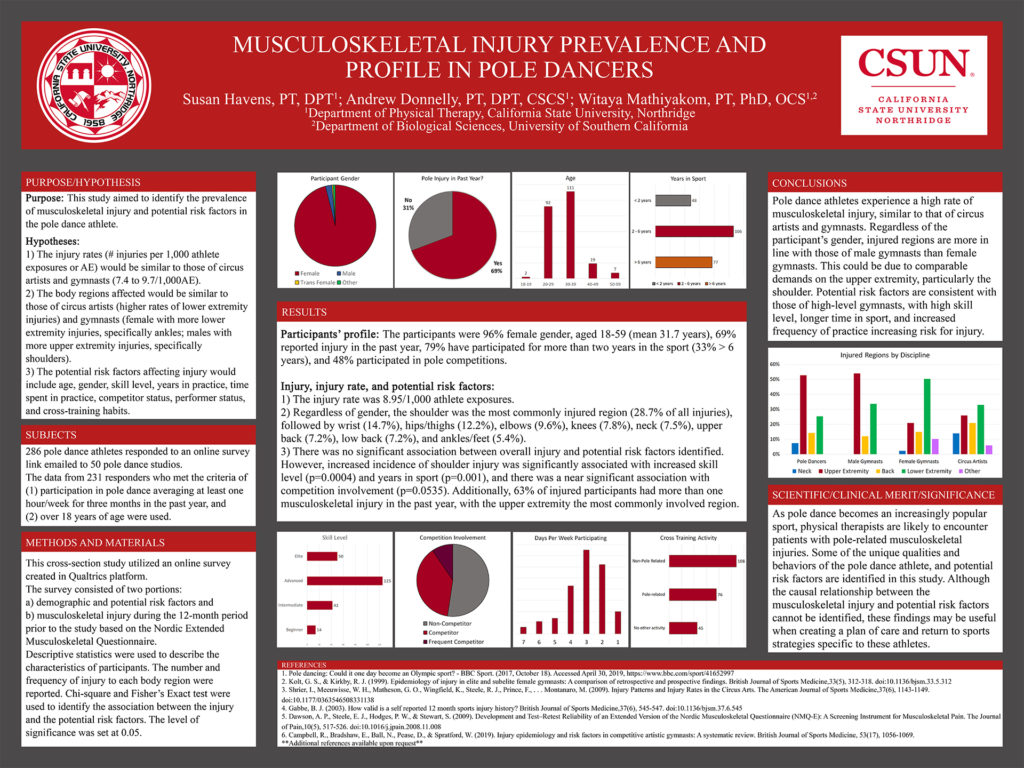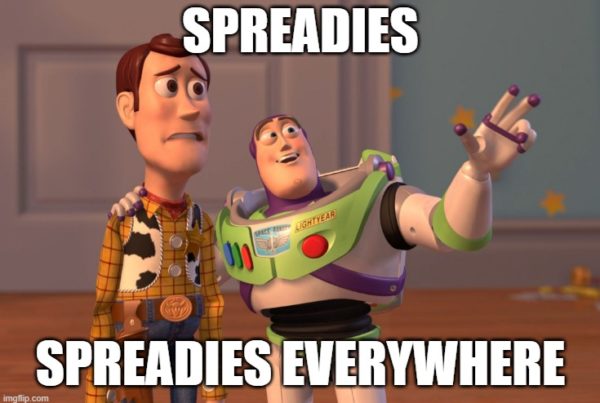Thank you, pole dancing science nerds of the world!
Since publishing my book (2 years ago – yikes!), so many interesting new injury studies have emerged from the scientific community. Yay!
I’m SO excited to finally have some juicy, juicy data on injuries in pole – and it’s absolutely crucial that, as an industry, we take note of what this research is telling us.
In this post, I’ll round-up recent injury studies and then talk more about how we can apply this kind of research ‘on the ground’ (or, should I say ‘in the air’?) to better inform our injury prevention practices.
*EDIT: Another pole dance injury study has been published since writing this blog post – you can see our key takeaways from that research here!*
Pole dance injury study #1: The injury-related characteristics of pole dancing as a recreational activity
At the time I was writing my book, Dr Joanna Nicholas’ doctoral research covering injuries in pole dance was the only pole-specific injury research study available. I’m so glad it has paved the way for more!
This research[1] involved a 12-month prospective injury surveillance study with 66 pole dancers taking part, from 41 different pole studios across Australia.
A total of 103 injuries occurred over the study and the total injury incidence was 8.39 per 1,000 activity hours.
No prizes for guessing that the shoulder joint was found to be the most commonly injured area (20.4%). The thigh area (more specifically, hamstrings) was second (11.7%).
59.2% of the injuries were acute and 40.8% were overuse injuries, with the reported primary culprit of shoulder injuries being loaded internal humeral rotation (oh hi twisted grip), and the majority of hamstring injuries resulting from front split manoeuvres.
Pole dance injury study #2: Musculoskeletal injury prevalence and profile in pole dancers
This study was conducted more recently by researchers at California State University, Northridge[2], the findings are yet to be fully published, but an informational poster with early findings is reproduced here, with their permission.

286 pole dancers took part in this online injury survey and, yup, you guessed it – it was shoulder injuries that topped the most commonly reported injury list (28.7% of all injuries reported), followed by wrists (14.7%), hips/thighs (12.2%) and elbows (9.6%).
69% of the 286 pole dancers who completed the survey reported an injury in the past year, with an injury rate of 8.95% per 1,000 athlete exposures, suggesting that injury rates in pole dance are similar to those of circus artists and gymnasts. The injury profile (based on the most commonly injured areas) was most similar to that of male gymnasts.
The findings also suggest that high skill level, longer time in the sport, and increased frequency of practice increases injury risk; consistent with risk factors in high-level gymnasts.
Pole dance injury study #3: Prevalence of pole dance injuries from a global online survey
Another web-based survey was conducted in March 2019 by researchers in Singapore[3] and published in the Journal of Sports Medicine and Physical Fitness in 2020.
The most commonly reported injuries were (I’m seeing a theme here) shoulder related (54.5%), followed by wrists (34.2%) and back injuries (24.7%).
The findings also suggest that there was a 3.9 x higher risk of moderate/severe injuries in those with 3 to 6 years of pole training experience vs. those with less experience.
Given that I am currently living my 40th year on this planet, it was interesting on a personal level to see that those pole dancers aged 40 and above were 3.7 times more likely to need more than 3 months to recover from injury.
Pole dance injury study #4: The risk of injuries and physiological benefits of pole dancing
In a classic pole dancers vs. muggles battle, this study compared 30 pole dancers with 30 untrained non-pole dancers. Researchers measured maximal hand strength, lower back, hamstring flexibility and body composition. Participants also completed a questionnaire about injuries.
The pole dancers were seen to have significantly greater muscle strength and lower back and hamstring flexibility, with less body fat and more muscle mass in the upper limbs. Yeah, we hench.
During 2 years of pole dancing, 36.7% of the pole dancers had sustained acute injuries (mainly muscle-based, shoulder joint and wrist injuries) and 80% of them had sustained a chronic injury. The injuries were reported to have occurred during “handsprings, twines and carousels”.[4]
Pole dance injury study #5: Types of the locomotor system injuries and frequency of occurrence in women pole dancers
A 2021 injury study[5] included 213 female pole dancers via an online questionnaire. 58% of participants reported an injury during training and ‘joint overload’ was the most cited cause.
The shoulder joint was the most injured area and, again, the incidence of injury was higher in professional dancers (50%) compared to amateur dancers (44%).
In amateurs, the other main injuries reported were: forearm (22%), hamstrings (19%) and ankles (19%).
In professional dancers: hamstrings (34%), wrists (22%) and spine (22%).
Pole dance injury study #6: A small series of pole sport injuries
This “study” is actually a case report[6] of 4 patients who presented at an Orthopedic injury clinic between 2011 and 2017 with acute injuries from pole. It provides sobering reading about the seriousness of falling injuries. The injuries sustained included a clavicle fracture, mild traumatic brain injury, cervical spinal distortion and ankle sprain.
The injuries were primarily the result of falls from inverted moves.
It made my soul a little sad to read that neither crash mats, nor spotters were used in any of the cases.
Research vs reality – how do we use this information to improve?
Here are my key takeaways from this research:
- If it wasn’t obvious before, we now have multiple studies confirming that pole dance has a *very* high injury rate. It’s a wake-up call on just HOW prevalent injuries in pole dance are.
- It confirms that the shoulder joint is the #1 area at risk of injury, with hamstrings, wrists/forearm, elbows, back and ankles also being significant high-risk areas.
- It suggests that more experienced pole dancers are more at risk than beginners and that older pole dancers (40+) may take longer to recover from injury than younger pole dancers.
- It highlights the seriousness and prevalence of acute injuries (particularly from falls off the pole) but also just how common overuse injuries are in pole dance, too.
Yes, more data is needed, but as far as I’m concerned, the research is in.
This is the nudge, if we needed one, that we desperately need to improve our management of injury risk in the pole community. We have enough evidence here to confirm the high risk of injury in pole dance and to highlight the main areas of injury, so what are we going to do about it?
Are we doing enough to prepare students for the demands of pole dance?
An important point was raised in the final injury report which I feel is worth repeating here…
“Our findings correspond to the observations by Ruscello et al[7]., who identified the forces acting on a pole athlete. They reported that high positive and negative vertical acceleration rates of up to 2G and rotation of 400° per second are reached in pole sport. We believe that many people performing pole sport do not fulfil the physical requirements necessary to withstand these forces.”
(Dittrich, Florian et al.)
I highlighted the last sentence of that quote because it’s the perfect segue back to the entire point of this blog post – the reason I’m pulling all this research together in one place.
Part of the ‘needs analysis’ that I conduct for individual athletes as a Strength and Conditioning Coach includes taking into consideration the physical demands and common injuries of the athlete’s sport. This information then guides which exercises and progressions might be needed in order to prepare the athlete’s body for those demands. In this way, the exercises included in an athlete’s training programme form a big part of injury risk management. It’s why I’m so excited to see this kind of research, because it leads the way in creating safe and sport-specific strength and conditioning programming.
But this isn’t just about exercise programming.
Yes, we can start to directly address and ‘prehab’ commonly injured areas (shoulders, hamstrings, wrists – we’re looking at you!) and we can be smarter about exercise programming to take into account what we know about pole dance injuries; but I believe that we also need to do a better job of prioritising injury prevention practices in our community, more generally.
This includes consideration and management of students’ (and our own) training loads, the promotion of gradual progression and good recovery strategies and a shift in culture and attitude when it comes to crash mats and safety.
This kind of change relies on leaders in the pole industry steering the community away from practices that might put students at greater risk of injury, promoting gradual training approaches and setting high safety standards. I see so many great things like this happening in the pole world already. So many pole dancers, instructors and studio owners are already working hard to create a better environment for their students and the pole dancers of the future. More of this please!
It has always been my #1 priority to be a part of that positive drive – to help encourage smart training habits amongst pole dancers and to give pole dancers information and tools to help them better prepare their bodies (and the bodies of their students) for the demands of pole. To this end, over the coming months, I’ll be working with our in-house physiotherapist, Georgina Watson, to provide some more actionable content – like pre-hab exercise ideas for pole dancers as well as general injury-risk management strategies to try and help spread this message of safe training – so please stay tuned on my social media channels if you want to keep exploring this important topic with me.
I’d also encourage you to read the studies mentioned in this article in full (references are provided below) – and if you come across any other pole dance injury studies I’ve missed, please send them my way so I can add them to the blog!
Let’s make sure this research effort has not been in vain – and please, please for the love of all that is poley, use a crash mat, folks!
*EDIT: Another pole dance injury study has been published since writing this blog post – you can see our key takeaways from that research here!*
[1] Nicholas, J 2019, The psychological, physiological, and injury-related characteristics of pole dancing as a recreational activity, Doctor of Philosophy, The University of Western Australia, https://doi.org/10.26182/5e7d60d09e2cd
[2] Havens, S, Donnelly, A, Mathiyakom, W. Musculoskeletal injury prevalence and profile in pole dancers, California State University, Northridge
[3] Lee JY, Lin L, Tan A. Prevalence of pole dance injuries from a global online survey, J Sports Med Phys Fitness. 2020 Feb;60(2):270-275. doi: 10.23736/S0022-4707.19.09957-2. Epub 2019 Oct 24. PMID: 31663312
[4] Naczk M, Kowalewska A, Naczk A. The risk of injuries and physiological benefits of pole dancing. J Sports Med Phys Fitness. 2020 Jun;60(6):883-888. doi: 10.23736/S0022-4707.20.10379-7. Epub 2020 Mar 11. PMID: 32162500
[5] Gołuchowska AM, Humka MI. Types of the locomotor system injuries and frequency of occurrence in women pole dancers. J Sports Med Phys Fitness. 2021 Jun 16. doi: 10.23736/S0022-4707.21.12239-X. Epub ahead of print. PMID: 34132513
[6] Dittrich, Florian et al. A small series of pole sport injuries. Orthopedic reviews vol. 12,3 8308. 24 Nov. 2020, doi:10.4081/or.2020.8308
[7] Ruscello, Bruno & Esposito, Mario & Pantanella, Laura & Partipilo, Filippo & Lunetta, Laura & Dottavio, Stefano. (2018). Biomechanics and Physiology in top level Pole Dancers. A case study. Journal of Physical Health and Sports Medicine. 10.36811/jphsm.2019.110001


![Mo skills, mo problems? Pole dance injury research [round up]](https://www.thepolept.com/wp-content/uploads/2021/08/Injury-blog-copy.jpg)





